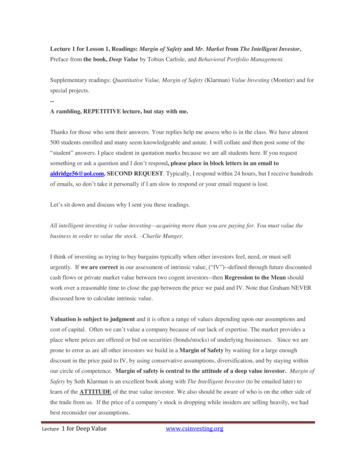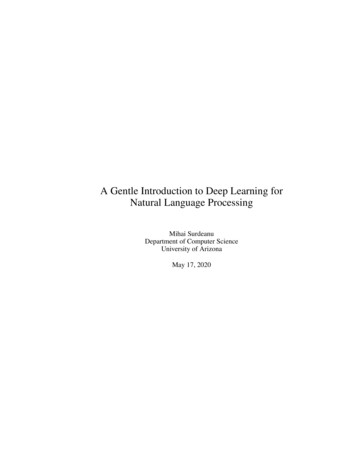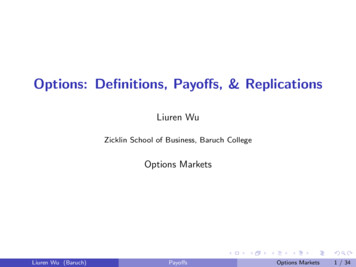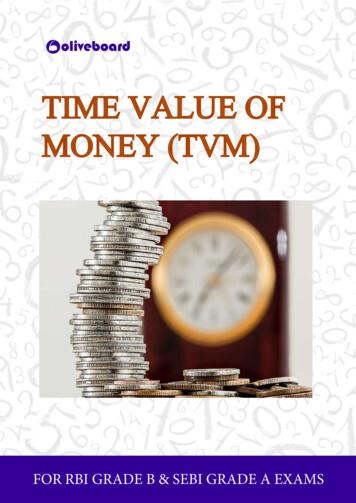
Transcription
Lecture 1 for Lesson 1, Readings: Margin of Safety and Mr. Market from The Intelligent Investor,Preface from the book, Deep Value by Tobias Carlisle, and Behavioral Portfolio Management.Supplementary readings: Quantitative Value, Margin of Safety (Klarman) Value Investing (Montier) and forspecial projects.-A rambling, REPETITIVE lecture, but stay with me.Thanks for those who sent their answers. Your replies help me assess who is in the class. We have almost500 students enrolled and many seem knowledgeable and astute. I will collate and then post some of the“student” answers. I place student in quotation marks because we are all students here. If you requestsomething or ask a question and I don’t respond, please place in block letters in an email toaldridge56@aol.com, SECOND REQUEST. Typically, I respond within 24 hours, but I receive hundredsof emails, so don’t take it personally if I am slow to respond or your email request is lost.Let’s sit down and discuss why I sent you these readings.All intelligent investing is value investing—acquiring more than you are paying for. You must value thebusiness in order to value the stock. –Charlie Munger.I think of investing as trying to buy bargains typically when other investors feel, need, or must sellurgently. If we are correct in our assessment of intrinsic value, (“IV”)--defined through future discountedcash flows or private market value between two cogent investors--then Regression to the Mean shouldwork over a reasonable time to close the gap between the price we paid and IV. Note that Graham NEVERdiscussed how to calculate intrinsic value.Valuation is subject to judgment and it is often a range of values depending upon our assumptions andcost of capital. Often we can’t value a company because of our lack of expertise. The market provides aplace where prices are offered or bid on securities (bonds/stocks) of underlying businesses. Since we areprone to error as are all other investors we build in a Margin of Safety by waiting for a large enoughdiscount in the price paid to IV, by using conservative assumptions, diversification, and by staying withinour circle of competence. Margin of safety is central to the attitude of a deep value investor. Margin ofSafety by Seth Klarman is an excellent book along with The Intelligent Investor (to be emailed later) tolearn of the ATTITUDE of the true value investor. We also should be aware of who is on the other side ofthe trade from us. If the price of a company’s stock is dropping while insiders are selling heavily, we hadbest reconsider our assumptions.Lecture1 for Deep Valuewww.csinvesting.org
We are the enemy!So here is our dilemma. We as Deep Value Investors (“DVIs”) seek to identify measurable and persistentbehavioral price distortions and then capitalize on those distortions. In other words, when people go crazy,we seek to take advantage. But people over-react, go crazy, fear loss, seek out certainty, and herd togetherbecause they are human, but so are we. What makes us special? Won’t we fall prey to those same biases?We will explore this further in the course.What is Value Investing?If you asked John Neff, Peter Lynch, Ben Graham, Seth Klarman, and Charlie Munger they might saybasically the same thing, buying a business for less than its worth, but their portfolios might all be different.We will be focusing on Deep Value stocks. These are losing stocks that become asymmetric opportunitieswith limited downside and enormous upside. Yes, but aren’t we trading off big upside with big risk? If wefactor in the risk of loss then are we really obtaining a bargain? What about value traps where valueerodes as fast as price? The key for us to focus on in this course will this second dilemma. Deep valuestocks may have a higher risk of bankruptcy individually, but as a group, the risk isOVERCOMPENSATED. In other words, we are highly compensated for taking the other side of thedistressed selling. Is that statement true? If investors over-react due to various biases like recency-bias,loss aversion, myopia, etc. AND the process of Mean Reversion works, then can we profit on a riskadjusted basis? At the end of this course, we should be able to answer that question. Any one of ourinvestments may go to 0.00 (What did Buffett say, “Rule 1: Don’t lose money and never forget rule 1.”Out of 20 mispriced opportunities, we may have three go to zero, two or three drop 50% and stay there, but14 rise and provide us with an adequate return.InvestmentResult 1.00 0.00 OUCH! 1.00 0.00 OUCH! 1.00 0.00 OUCH! 1.00 0.50 Help! 1.00 0.50 Help! 1.00 1.20 1.00 1.20 1.00 1.20 1.00 1.50 1.00 1.50 1.00 1.50 1.00 1.00 1.00 1.75 1.00 2.00Lecture2 for Deep Valuewww.csinvesting.org
1.00 1.00 1.00 1.00 1.00 1.00 20.0020 invs. 2.00 2.00 2.50 1.30 1.30 1.50 24.4522.50%returnMy goals for students are:You (and I) are the enemy thus we need to build protections against our flaws. Investing often goesagainst the grain of how our brains evolved. See the grass rustle, a tiger lurks. Don’t think about it—RUN!See the plunging price of my stock, sell! We are hardwired to react QUICKLY to danger or else wewouldn’t be here (our ancestors wouldn’t have passed on their genes). Recognized that we are as flawed,fearful, hopeful, and subject to emotion as others. We must figure out a way to work around our naturalinstincts. Buffett and Graham spoke of temperament and character being more important than IQ. So howwill we develop such character? We will try in this course.Practice thinking independently (Be skeptical/prove it to yourself). This will take courage and solitude.If you are not comfortable sitting alone in a room reading and thinking, then investing alone may not be thebest use of your time. That’s OK; you must find a path for yourself. Don’t waste time seeking out gurus foradvice. Mr. Market is there to serve you not guide you. Can you imagine walking into a grocery store/foodmarket and asking the vendor how much you should buy and at what price? No. Good. Wall Street or the“Market” can’t tell you what you should do. Wall Street is there to generate fees and commissions whileraising capital for businesses and transacting trades. Two timeless books on Wall Street are Where Are theCustomers’ Yachts or A Good Hard Look at Wall Street by Fred Schwed, Jr. and the Money Game by“Adam Smith” (Jerry Goodman). Finally, Reminiscences of a Stock Operator by Edwin Lefevre is aclassic on the psychology of traders, investors, and brokers. I suggest an annual rereading of these classicsto calm the nerves. Since human nature hasn’t changed, people tend to react similarly. Or, as a Wall Streetveteran remarked, “The music never changes, just the players.”Try to read original source documents rather than a second-hand source. Read a company’s 10-K ratherthan a brokerage report’s buy recommendation. We will be reading several of the research reports that theauthor of DEEP VALUE read to write his book.Lecture3 for Deep Valuewww.csinvesting.org
Investing is most successful when most businesslike. Students need to treat their investing like a business.You should know your philosophy, methodology, and strengths/weaknesses of your approach while beingmeticulous in recording/tracking your investments/progress. Be rational. How will you learn from yoursuccesses and mistakes? For example, since deep value investing may be highly counter-cyclical to thegeneral market, you may widely “underperform” a benchmark index for a long period of time. The patiencerequired is difficult and uncertainty is often confused with risk.Risk is meaningless without a preceding adjective. Risk is not volatility but permanent loss of capital.(Unless you are heavily leveraged). Risk could be: operational, political, management, or financial risk. Orthe risk could be YOU—your emotional state, your hubris, and/or undisciplined actions.Students should realize that investing is simple but not easy. Prof. Joel Greenblatt in his MBA class andhis book, The Little Book that Beats the Market (to be emailed later) says that all he does is figure out whata business is worth and then pay a whole lot less for it. Seems simple but how to go from here to there?Prof. Greenblatt also says he is not better at analyzing companies than many Wall Street analysts but heknows what he knows (his circle of competence) and he weights mispriced bets. When he often can’t valuea company, he moves on. Investing is something you do (or not do until you do decide to act). As aninvestor always consider who is on the other side of the trade from you so you don’t become the patsy orfool at the poker table. A fool ceases to be a fool when he or she quits/corrects the mistake. The deepvalue investor is seeking out mispriced securities however that is determined.Many readers say their goal is to become better at determining intrinsic value (“IV”) because then theywould have the knowledge and confidence to buy and sell when prices move away from IV.HOWEVER .My bias is that it is NOT difficult to find price below value when there is extreme panic or distress on thepart of sellers, but the difficulty lies in ACTING to seize the opportunity. Even DEEP VALUE investorsare human with all the same biases as others. When the company’s stock is plummeting, analysts aredowngrading their earnings estimates, the news for the industry’s future is terrible, and then perhaps, wefear, the value we see isn’t there. Our fears overcome us. “Don’t you read the papers, your friends andcolleagues scream! We will wait until we gain more certainty—we practice REARVIEW investing. Webecome part of the same herd that will act emotionally to provide us with mispricing. Walking across aplank isn’t hard, but when that plank is perched between two cliffs 1,000 feet above the ground, then thedifficulty increases. Noise overwhelms the signal; our fears stop us from acting. Are we trapped in ourhumanness?Lecture4 for Deep Valuewww.csinvesting.org
If knowledge was all we needed, then why are there so many fat (obese) Americans when 100s of dietbooks are published each year? How can we close the yawning gap between knowing and doing?The video of the crash landing in the Hudson should teach you the importance of remaining rational/calmwhile following a process. The pilot went through his checklist of seeking an alternative airport, and heremained focused in flying the plane to the water. He wasn’t focused on being killed if he made a mistake;he remained focused in the moment because that was all he could control. Was he lucky? He hadtremendous flying skill, but the weather was clear so he was fortunate in that respect. Never forget theimportance of randomness/luck. I think with practice one can train oneself to be calm/rational in stressfulsituations. Studying past market cycles/financial history and understanding the industries and the financialcharacteristics of businesses should help you in developing realistic assumptions. Also, developingconfidence in regression to the mean will steady you. Always allow for being in error. Only BenBernanke is 100% confident that the Fed has EVERYTHING under control.Behavioral Portfolio Management (The Next Paradigm) shows how one money manager, C. ThomasHoward built a method to protect himself from behavioral errors. We will dig deeper into this article withthe help of a “volunteer.”PS: A reader mentions:I have a splinter in my mind.In regards to the poker video, a better scene would have been if Teddy made a bet not getting the rightpot odds implied or otherwise.For example, if the board was 6-7-k and Matt had 8-9 he would have an open end straight draw. Hewould make straight with one of four 10s or four 5s. 8 outs total. With two cards to come he has about32% chance of making a straight or about 1:3. If he is getting 10:1 on his he's got to go for it. 1:1 hehas to fold.Teddy, on the other hand, has to create a situation that would put Matt in a position for him to choose tomake a bad bet. Like making it so expensive for him to draw; putting 70% of his chips to gain only 30% inthe pot.When people either don't know the odds or know the odds and don't follow them due to emotion, bothlead to poor long term results.Let’s continue on our journey.Lecture5 for Deep Valuewww.csinvesting.org
Margin of safety is central to the attitude of a deep value investor. Margin of Safety by Seth Klarman is an excellent book along with The Intelligent Investor (to be emailed later) to learn of the ATTITUDE of the true value investor. We also should b










